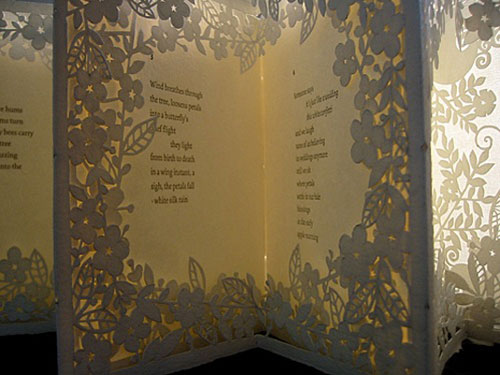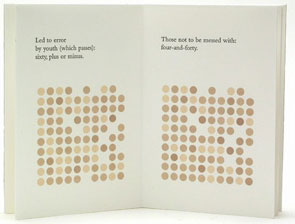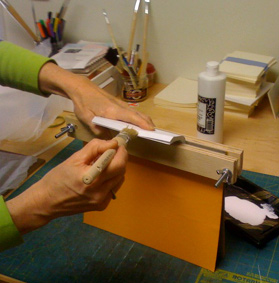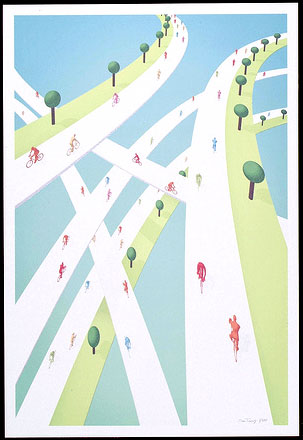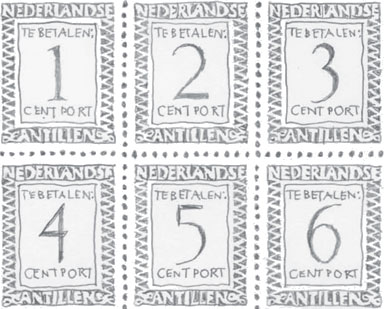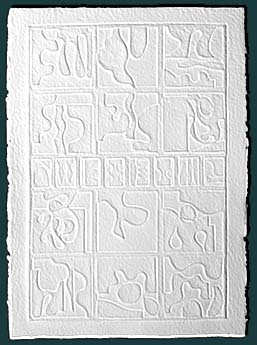 Sometimes a subject keeps coming up over and over and I think maybe I should pay attention — recently it’s papermaking. First were the cast paper things I saw late last year at an exhibit of work by Louise Nevelson at the de Young Museum. (That’s one of her castings to the left — it’s called “Dawn’s Presence” — it’s 31×21 inches to give you an idea of the size. I’m not sure if that’s one I saw at the de Young but it’s got the same feel. Of course the gift shop didn’t have a postcard of the paper pieces so I bought one of something that seemed similar. It’s pinned up to my wall by my work table and every time I look at it I remember how much I liked the paper casting pieces.) Then Ginger Burrell has been writing a 3 article series for Ampersand on using handmade paper in artists’ books (she’s done 2 already, one more in the Spring issue). In her bibliography, Ginger recommends “any book by Helen Hiebert”… and late this summer Helen is giving a class at San Francisco Center for the Book called Paper Lamps, Lanterns & Sculpture (which I first noticed because it isn’t really about books or book art, but do take a look at her lamps — many of them weirdly wonderful.) And then last week I saw an announcement about the non-profit Handmade Papermaking‘s annual fundraising auction of papermaking related stuff, which caused me to spend a pleasant half hour looking at the auction and then for papermaking classes in the Bay Area… although I don’t have any concrete ideas yet on how to use paper I’ve made in a book — seems like that’s always the impetus I need to start learning a new technique. And I also keep looking at the pulp painted paper chapbook I got at Codex for inspiration (it too is prominently displayed on my work table).
Sometimes a subject keeps coming up over and over and I think maybe I should pay attention — recently it’s papermaking. First were the cast paper things I saw late last year at an exhibit of work by Louise Nevelson at the de Young Museum. (That’s one of her castings to the left — it’s called “Dawn’s Presence” — it’s 31×21 inches to give you an idea of the size. I’m not sure if that’s one I saw at the de Young but it’s got the same feel. Of course the gift shop didn’t have a postcard of the paper pieces so I bought one of something that seemed similar. It’s pinned up to my wall by my work table and every time I look at it I remember how much I liked the paper casting pieces.) Then Ginger Burrell has been writing a 3 article series for Ampersand on using handmade paper in artists’ books (she’s done 2 already, one more in the Spring issue). In her bibliography, Ginger recommends “any book by Helen Hiebert”… and late this summer Helen is giving a class at San Francisco Center for the Book called Paper Lamps, Lanterns & Sculpture (which I first noticed because it isn’t really about books or book art, but do take a look at her lamps — many of them weirdly wonderful.) And then last week I saw an announcement about the non-profit Handmade Papermaking‘s annual fundraising auction of papermaking related stuff, which caused me to spend a pleasant half hour looking at the auction and then for papermaking classes in the Bay Area… although I don’t have any concrete ideas yet on how to use paper I’ve made in a book — seems like that’s always the impetus I need to start learning a new technique. And I also keep looking at the pulp painted paper chapbook I got at Codex for inspiration (it too is prominently displayed on my work table).

